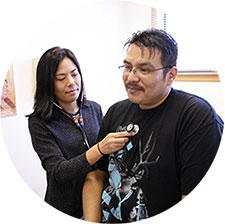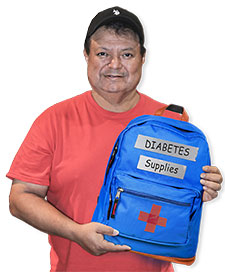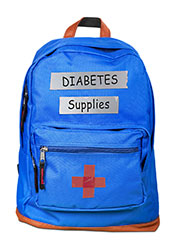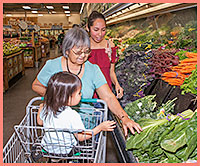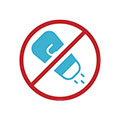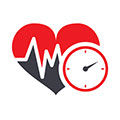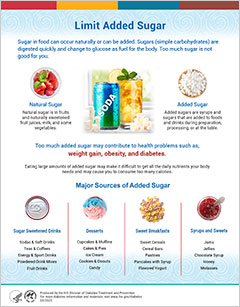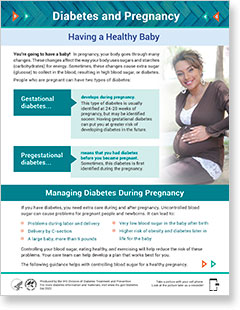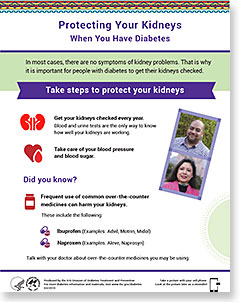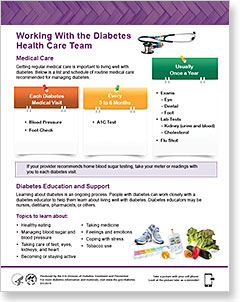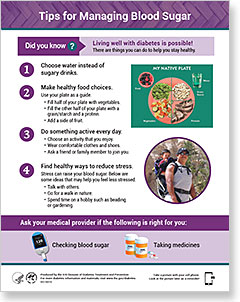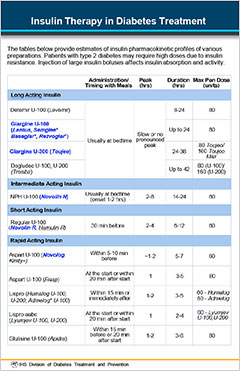Education Materials and Resources (Online Catalog)
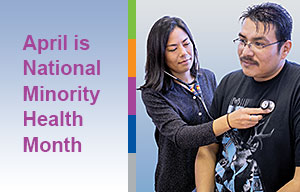
FEATURED MATERIALS/RESOURCES
April is National Minority Health Month
Find free, culturally-relevant materials to prevent and treat diabetes and diabetes-related conditions. Read and share with your patients, clients, friends, and family members.
-
Diabetes Basics
Diabetes Information for You and Your Family
How does diabetes happen?
Diabetes happens when the body:
Share
View Handout [PDF – 655 KB]
- Does not make enough insulin
- Does not use insulin well
- Stops making insulin
Insulin is made by the body to help move sugar from the blood to the muscles and other parts of the body.
About Type 2 Diabetes
What is type 2 diabetes?
Type 2 diabetes is when the body does not use insulin well and does not make enough insulin. This is the most common type of diabetes.
The chances for type 2 diabetes are higher if you:
- Have a parent, brother, or sister with diabetes
- Have ever had diabetes during pregnancy
- Are overweight
- Are not physically active
- Have prediabetes
Prediabetes is having blood sugar levels higher than normal but not high enough for diabetes.
Symptoms of Diabetes
- Increased thirst
- Increased hunger
- Feeling very tired most of the time
- Increased urination
- Unexplained weight loss
- Blurred vision
These symptoms can be severe or mild. Some people may not have any symptoms.
How can you find out if you have diabetes?
A blood test will show if you have diabetes. Ask your health care provider about getting tested and where you can get more information.
Take Steps to Manage Diabetes
Even though diabetes is long lasting, there are things you can do to stay healthy. Consider the following things and ask your health care provider if it is right for you.
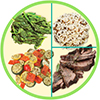 Make healthy food choices.
Make healthy food choices.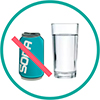 Choose water instead of sugary drinks.
Choose water instead of sugary drinks. Stay active.
Stay active.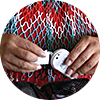 Check your blood sugar.
Check your blood sugar.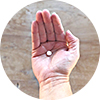 Take medicine.
Take medicine.Find healthy ways to cope with stress.
Everyone has a different experience with diabetes. Sometimes it can be tough. Having support from family, friends, and others with diabetes can be helpful. There may be a diabetes education program at your clinic or in your community.

Diabetes and Emergencies
When a crisis happens, medication, water, or diabetes supplies may be hard to get. By planning ahead you can act quickly. Have an emergency kit ready to go so you can better manage your diabetes away from home.
Build an Emergency Kit
Get a backpack or box that holds a week or more worth of supplies. Stock the kit with items that apply to you on the checklist. Place the kit where you can grab it and go. See more at Ready.gov on how to build your kit.
Share
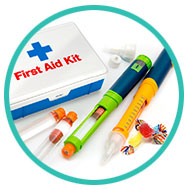
Diabetes Medical Supplies for 1-2 weeks
- Prescriptions and over-the-counter medications taken by mouth, inhaled, or injected
- Glucose meters, test strips, lancets, and batteries
- Continuous glucose monitoring supplies
- Insulin pens, needles, and syringes
- Insulin pump supplies
- Glucose tablets, juice boxes, or hard candy to treat low blood sugar
- Hand sanitizer and sanitizing wipes
- First aid kit
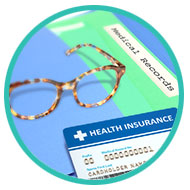
Personal Information and Items
- Current medication list, along with your pharmacy and provider’s contact information
- Copies of important records, identification, and health insurance cards
- Extra cell phone charger
- Extra pair of glasses or contact lenses, as needed
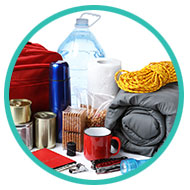
More Essentials for Your Kit
A 3-day supply of food, water, and other essentials to pack
- Non-perishable food such as peanut butter, crackers, protein bars and shakes, tuna, sardines, nuts, and canned fruit
- A can opener and eating utensils
- One gallon of water per day
- Radio, flashlight, and extra batteries
- A warm blanket and a change of clothing
Create an Emergency Plan
Talk with family members about why and how to prepare for disasters common to your area.
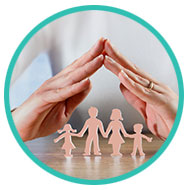
Things to consider
- Discuss where to meet in case you are separated from your family. Include a back-up location.
- Plan how you will stay in touch if phones and internet are out.
- Decide what tasks need to be done by each household member.
- For more help with making your emergency plan, see the American Red Cross Disaster Preparedness Plan.
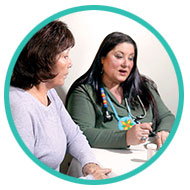
If you have disabilities or other medical needs:
- Decide what you might need during and after an emergency.
- Talk with your caregivers to help you prepare your emergency plan.
- For help making a plan for people with disabilities, see the American Red Cross, Disaster Safety for People with Disabilities.
Diabetes and Pregnancy
Having a Healthy Baby
You’re going to have a baby! In pregnancy, your body goes through many changes. These changes affect the way your body uses sugars and starches (carbohydrates) for energy. Sometimes, these changes cause extra sugar (glucose) to collect in the blood, resulting in high blood sugar, or diabetes.
Share
People who are pregnant can have two types of diabetes:
Gestational
diabetes...develops during pregnancy.
This type of diabetes is usually identified at 24-28 weeks of pregnancy, but may be identified sooner. Having gestational diabetes can put you at greater risk of developing diabetes in the future.
Pregestational
diabetes...means that you had diabetes before you became pregnant.
Sometimes, this diabetes is first identified during the pregnancy.

Managing Diabetes During Pregnancy
If you have diabetes, you need extra care during and after pregnancy. Uncontrolled blood sugar can cause problems for pregnant people and newborns. It can lead to:
- Problems during labor and delivery
- Delivery by C-section
- A large baby, more than 9 pounds
- Very low blood sugar in the baby after birth
- Higher risk of obesity and diabetes later in life for the baby
Controlling your blood sugar, eating healthy, and exercising will help reduce the risk of these problems. Your care team can help develop a plan that works best for you.
The following guidance helps with controlling blood sugar for a healthy pregnancy.
 Eat healthy foods.
Eat healthy foods.Good nutrition is an important tool to help control blood sugar. A dietitian can work with you to create an individualized meal plan.
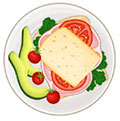
Eat 3 small meals a day.
Choose foods and drinks low in added sugar. Include vegetables, protein, and whole grains in each meal.
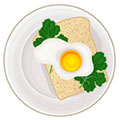
Eat breakfast every day.
Include a protein and a whole grain, such as an egg and a small bowl of oatmeal. Avoid having fruit with breakfast.
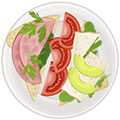
Eat 2 or 3 snacks a day.
Combine a fruit, yogurt, or whole grain with a protein or a healthy fat, such as nuts or avocado.

Drink water, milk, and unsweetened beverages.
Limit caffeine and artificial sweeteners. Avoid energy drinks, fruit juices, and sugary drinks.
 Be active.
Be active.Activity helps to lower blood sugar levels. Light exercise is best, such as walking, dancing, and yoga. Even a 15-minute walk helps lower blood sugar. Ask your provider about exercise during pregnancy.
 Test your blood sugars often.
Test your blood sugars often.
Use a glucose meter to keep track of your blood sugar throughout the day. Your provider or team will help you learn how and when to do testing, and what your blood sugar targets should be.
 Take your medications.
Take your medications.If you have gestational diabetes, you may need to use insulin or other medications to control blood sugar. If you have pregestational diabetes, changes to your medications will be needed during pregnancy.
 Avoid alcohol, tobacco, street drugs, and medications
that your provider hasn’t prescribed.
Avoid alcohol, tobacco, street drugs, and medications
that your provider hasn’t prescribed.These substances can harm you and your baby. If you need help quitting, talk to your healthcare provider who can refer you to resources.
After Your Baby is Born
- Continue to eat healthy, be physically active, and keep your weight within a healthy range.
- Breastfeed your baby to reduce your risk of diabetes. If you have diabetes, breastfeeding will help with blood sugar control. Breastfed babies have a lower risk of developing obesity and diabetes later in life.
- Get tested for diabetes six weeks after your baby is born and then once a year if you had gestational diabetes.
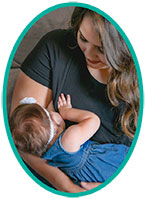
Stress and Diabetes
Managing Stress When You Have Diabetes
Life is stressful at times. Having diabetes can also add stress, along with worries about work, family, or school. When stressed, your blood sugars can increase and be harder to control.
Learning how to deal with stress can lead to a more balanced life. It is a way of caring for yourself and managing diabetes.
Share
When I first found out I had diabetes, I was devastated. I kept having a helpless thought. I decided to choose to find reasons and ways to be joyful every day. I worked at it and prayed for it. I got help from the Creator, family, and friends.
Stress and Everyday Life
Stress can be felt in emotional and physical ways. Emotions could show as anxiety, frustration or anger. Your body could experience rapid breathing, tense muscles, headaches or stomach pain.
Stress can be temporary or last a long time. Ongoing stress is often harder to deal with and can affect work, relationships, and health. With help, stress can be reduced.

Barbara Mora and husband, Bob.

Unhealthy Responses to Stress
- Using commercial tobacco more than usual
- Overeating
- Increased alcohol use
- Spending hours watching TV or social media
- Avoiding friends and relatives
At first, these ways of coping might feel like they help, but over time may become harmful to your physical and mental health.
Healthy Ways to Manage Stress
Finding ways to cope with stress is good for your mind and body. Reducing stress can also help with blood sugar and diabetes control. Talking with your care provider can help if you often feel overwhelmed or depressed. Consider writing about your feelings in, A River Runs Through Us, 90-Day Journal for Wellness.
To order your free copy visit, www.ihs.gov/diabetes/education-materials-and-resources/

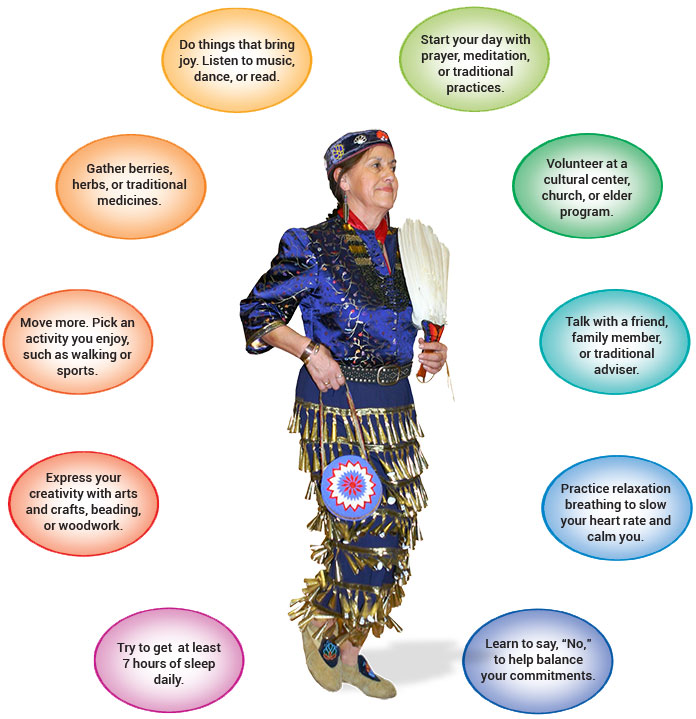
Working With the Diabetes Health Care Team
Medical Care
 Getting regular medical care is important to living well with diabetes. Below is a list and schedule of routine medical care recommended for managing diabetes.
Getting regular medical care is important to living well with diabetes. Below is a list and schedule of routine medical care recommended for managing diabetes.Share
Each Diabetes Medical Visit
- Blood Pressure
- Foot Check
Every 3 to 6 Months
- A1C Test
Usually Once a Year
- Exams
- Eye
- Dental
- Foot
- Lab Tests
- Kidney (urine and blood)
- Cholesterol
- Flu Shot
If your provider recommends home blood sugar testing, take your meter or readings with you to each diabetes visit.
Diabetes Education and Support
Learning about diabetes is an ongoing process. People with diabetes can work closely with a diabetes educator to help them learn about living well with diabetes. Diabetes educators may be nurses, dietitians, pharmacists, or others.
Topics to learn about:
- Healthy eating
- Managing blood sugar and blood pressure
- Taking care of feet, eyes, kidneys, and heart
- Becoming or staying active
- Taking medicine
- Feelings and emotions
- Coping with stress
- Tobacco use
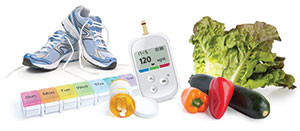
Diabetic Eye Disease
What is diabetic eye disease?
Diabetic eye disease can happen when a person has high blood sugar over a long period of time. This causes blood vessels in the back of the eye to leak or bleed. It can occur in one or both eyes. This is called retinopathy.
How do you know if you have diabetic eye disease?
Share
There are often no warning signs. The only way to know if you have diabetic eye disease is by getting your eyes checked. People with diabetes need to get their eyes checked at least once a year.
There are two ways to check:
 Get a dilated eye exam by an eye doctor.
Get a dilated eye exam by an eye doctor. Some clinics can screen for diabetic eye disease by taking pictures of the back of your eyes.
Some clinics can screen for diabetic eye disease by taking pictures of the back of your eyes.You can help prevent or slow diabetic eye disease.
 Manage your blood sugar and blood pressure.
Manage your blood sugar and blood pressure. Take your medicines as prescribed.
Take your medicines as prescribed. Get an eye exam every year.
Get an eye exam every year.How is diabetic eye disease treated?
People who have diabetic eye disease are seen more often by an eye doctor. They may also need the following:
- Eye medicines
- Laser treatment
- Surgery
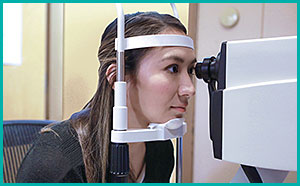
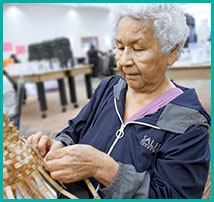
Diabetes increases the risk for common eye problems, such as cataracts and glaucoma.
- Cataracts are cloudy areas in the lens of the eye.
- Glaucoma happens when there is increased pressure in the eye.
- Your eye doctor can check for these eye problems during an eye exam.
 If you notice sudden changes in your vision, such as dark spots or vision loss, get checked by a health care provider right away.
If you notice sudden changes in your vision, such as dark spots or vision loss, get checked by a health care provider right away. Women with diabetes need to get an eye exam if they are planning to become pregnant and while they are pregnant.
Women with diabetes need to get an eye exam if they are planning to become pregnant and while they are pregnant.Keeping Your Feet Healthy
Diabetes Information for You and Your Family
Healthy feet help us to take care of ourselves and our families. We depend on them daily. Many people also use them to walk familiar trails and to take part in traditions, such as dances and ceremonies. For people with diabetes, controlling blood sugars is important to keep feet healthy.
Here are three things you can do to take care of your feet:
Share
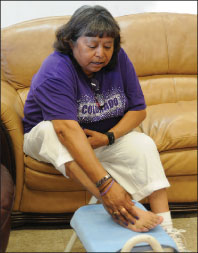
Check your feet every day.
Donna Cardoza,
Santo Domingo Pueblo, NM1. Check your feet every day.
- Look at your feet for cuts, sores, red or swollen areas, and blisters.
- Check for infected or ingrown toenails.
- If you need help checking your feet, use a mirror or ask a family member to help you.
2. Get help if you find a foot problem.
- If you find any problems during your daily foot checks, contact your health care team right away.
- Getting help early can keep small problems from becoming bigger problems.
3. Quit using commercial tobacco or never start.
- Tobacco use reduces blood flow to your feet.
- Ask your health care team about things you can do to quit using commercial tobacco.
- Call 1-800-QUIT-NOW (1-800-784-8669) for free help.
- Avoid being around others who are smoking, including in the car.
At each clinic visit, take off your shoes and socks.
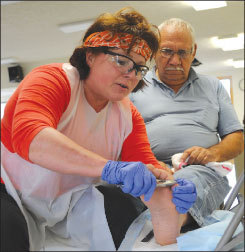
Partner with your health care team.
Mary Schwiderson, RN
Walter LeBlanc,
Bay Mills Tribe, MIAsk a member of your health care team to:
- Check your feet.
- Show you how to care for your feet.
- Trim your toenails or take care of corns and calluses, if needed.
- Suggest special shoes or inserts to help protect your feet.
What are other ways you can keep your feet healthy?
Wear shoes indoors and outdoors. Do not go barefoot.
- Wear comfortable shoes that fit well and protect your feet.
- Shoes should have round toes and low heels.
- Avoid shoes that are open at either the toe or the heel.
- Before putting your shoes on, check inside each shoe to make sure there are no objects, such as a small rock.
- Wear socks to help prevent getting blisters and sores.
Protect your feet from hot and cold.
- Keep your feet away from heaters, open fires, and heating pads. You may burn your feet and not know it.
- Wear socks at night if your feet get cold.
Wash your feet often.
- Avoid using water that is too hot.
- Dry your feet well, including between your toes.
Put lotion on your feet daily.
- Apply lotion on the tops and bottoms of your feet, but not between your toes.
- Moisture between the toes can make the skin soften and break down, which can lead to infection.
Trim your toenails or ask for help.
- Trim your toenails straight across using toenail clippers.
- Do not use knives or sharp tools to cut the skin close to your toenails, or anywhere else on your feet.
- Ask for help trimming your toenails from a family member or health care team if you:
- Cannot see well.
- Have poor feeling in your feet.
- Cannot reach your feet.
- Have thick toenails.
Report foot problems early.
It is important to get foot problems checked and treated right away. Ask your health care provider about treatment options. They may refer you to a foot or wound care specialist, if needed.Checking Your Blood Sugar
Living well with diabetes means knowing how food, activity, and diabetes medications affect your blood sugar. Checking your blood sugar regularly provides information you can use to adjust eating habits and activities to manage your diabetes.
What numbers are right for you?
Blood sugar goals vary from person to person. Talk to your health care team about your goals and what is best for you.
Share
Getting started
Your health care team can help you decide if and when to check your blood sugar. They can provide a blood sugar meter and instructions on how to use it.
When to check
Work with your health care team to make a plan for testing your blood sugar. Common times to check are:
- When you first wake up and before you eat (fasting)
- Before meals
- 2 hours after the start of a meal
- At bedtime
Different ways to check your blood sugar
 Blood sugar meters are small devices used to check blood sugar levels. The results show the amount of sugar in the blood at the time of the test.
Blood sugar meters are small devices used to check blood sugar levels. The results show the amount of sugar in the blood at the time of the test. Continuous Glucose Monitoring (CGM) uses a tiny sensor under the skin to check blood sugar levels every 1 to 5 minutes, 24-hours a day. CGM devices can be linked to a cell phone.
Continuous Glucose Monitoring (CGM) uses a tiny sensor under the skin to check blood sugar levels every 1 to 5 minutes, 24-hours a day. CGM devices can be linked to a cell phone. Hemoglobin A1C is a lab test that measures your average blood sugar level over the past 2 to 3 months.
Hemoglobin A1C is a lab test that measures your average blood sugar level over the past 2 to 3 months.Goals for Blood Sugar* My Blood Sugar Goals Fasting or before a meal: 80 to 130 mg/dl 2 hours after meals: Below 180 mg/dl A1C: Less than 7% for most adults * These are general recommendations for people with diabetes who are not pregnant. Blood Sugar Highs and Lows
High Blood Sugar Low Blood Sugar What is it? Also known as Hyperglycemia.
May or may not have symptoms.Also known as Hypoglycemia.
Usually lower than 70 or when having
symptoms of low blood sugar.Why is it
important?High blood sugar can cause low energy
and long-term damage to eyes, kidneys,
feet, and other parts of the body.Our brains need sugar to work well.
Low blood sugar can cause confusion
or fainting.What are some
symptoms?Weakness, blurred vision, thirst, or
urinating (peeing) often.Hunger, confusion, dizziness, shakiness,
or fast heartbeat.What to do? If your blood sugar is too high, drink
water and limit sugars and starches. Talk
to your health care provider.Treat low blood sugar. Have a
sugary item, such as 4 oz. of juice, 4
glucose tabs, or 1 glucose gel. Retest
in 15 minutes.If your blood sugar levels are too high or too low, you may need to make changes to:
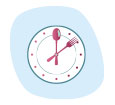
What or when you eat and drink

Medications
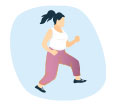
Physical activity

Managing stress
Going UP
Things that may cause hyperglycemia
- Eating more than usual or a large meal
- Forgetting your diabetes medication
- Dealing with stressful situations
- Having an illness or infection
Going DOWN
Things that may cause hypoglycemia
- Eating less than usual or skipping meals
- Being more active than usual
- Taking more medication than prescribed by your provider
What is a Continuous Glucose Monitor
Continuous glucose monitors (CGMs) are devices you wear that give you minute-by-minute readings on how glucose (sugar) levels are going up and down. CGMs have alarms to alert you if your sugar goes too high or too low.
CGMs help you understand how diabetes medications (especially insulin), food, exercise, stress, and sick days affect your blood sugar. Understanding your blood sugar patterns may make it easier to reach your target A1c.
Share
View Handout [PDF – 2.6 MB]
How does a CGM work?
Sensor
The CGM sensor is disposable. It uses a thin flexible material, called a filament, to measure sugar in the fluid under your skin. It is held on by an adhesive, allowing you to shower or swim. Most sensors last 10-14 days.
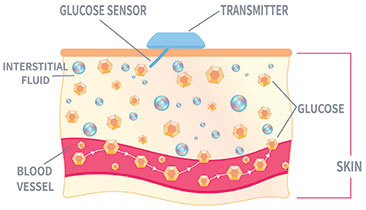
Transmitter
The transmitter is attached to the sensor and sends sugar values to the reader or a smart phone with a CGM application. Using a wireless connection CGMs transmit values every 1-5 minutes.
Reader
A reader displays your sugar levels throughout the day. It is a device about the size of a cell phone. You may be able to view and share the information with those you authorize, such as a family member or your health care provider.
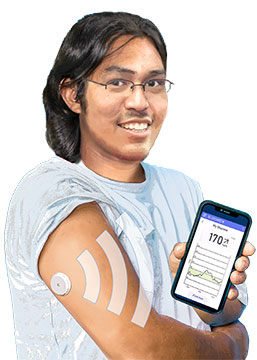
A Sample Continuous Glucose Monitor Data Graph
The CGM data graph shows glucose levels over time. In this example, the target range (usually 70-180 mg/dL) is in green. A sugar target is the number range you try to stay within. This can vary depending on your age and health issues.
CGMs can also show the percentage of time in a day that sugars have been in the target range. Treatment plans can be changed based on the patterns shown in your data graph.
The American Diabetes Association recommends that a person with diabetes aim for a time in range of at least 70 percent of readings (not high or low).
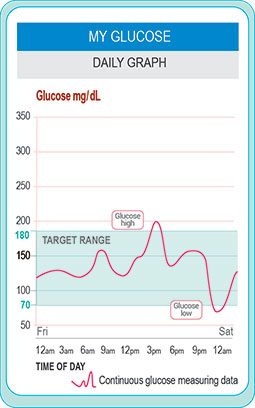
What are some pros and cons of CGM use?
Pros of CGMs
- Continuous sugar readings for care decisions
- No finger sticks
- Alerts for high or low blood sugars
- Notifies caregivers so they can respond
Cons of CGMs
- Possible skin irritation or sensitivity to adhesive
- Sensor may get caught on clothing and come off
- Sensors need to be replaced every 10-14 days
- Transmitters require Internet and Bluetooth connectivity
Low Blood Sugar
Know the Symptoms of Low Blood Sugar.
Low blood sugar can be a problem. You may feel one or more of the symptoms below when your blood sugar is getting low. Some people may not feel any symptoms.
Share
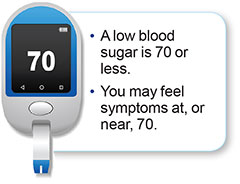

What To Do If You Have Low Blood Sugar Symptoms.
If you have your meter nearby, check your blood sugar. It is okay if you cannot check. It is more important to treat your symptoms right away.
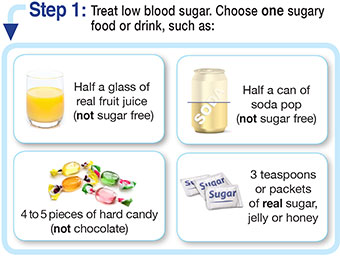
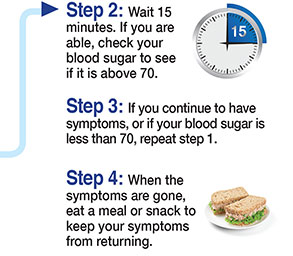
Talk to Your Health Care Provider.

Let your health care provider know if you are having symptoms of low blood sugar. You may need a change in your medicine.
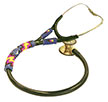
Tips for Managing Blood Sugar
Did you know?
Living well with diabetes is possible!
There are things you can do to help you stay healthy.
Share

Choose water instead of sugary drinks.

Make healthy food choices.
Use your plate as a guide
- Fill half of your plate with vegetables.
- Fill the other half of your plate with a grain/starch and a protein.
- Add a side of fruit.

Do something active every day.
- Choose an activity that you enjoy.
- Wear comfortable clothes and shoes.
- Ask a friend or family member to join you.

Find healthy ways to reduce stress.
Stress can raise your blood sugar. Below are some ideas that may help you feel less stressed.
- Talk with others.
- Go for a walk in nature.
- Spend time on a hobby such as beading or gardening.
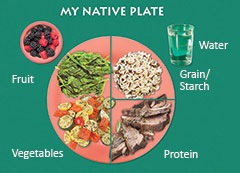
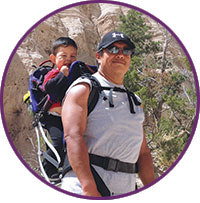
Ask your medical provider if the following is right for you:

Checking blood sugar

Taking medicines
Blood Pressure and Diabetes
What You Need to Know
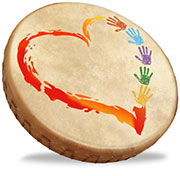
The heart is an amazing, life-giving organ
The heart works well under pressure, but blood pressure that gets too high (hypertension) makes your heart work harder. People develop hypertension as a result of many conditions, including injury to the kidneys from diabetes. If it is not treated, hypertension can cause damage to your heart and blood vessels, raising your chances of heart attack, stroke, worsening kidney problems, amputation, and blindness. There may not be any warning signs or symptoms.
Share
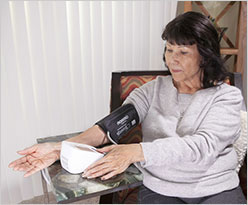 An estimated 4 out of 5 American Indian and Alaska Native people with diabetes also have hypertension.
An estimated 4 out of 5 American Indian and Alaska Native people with diabetes also have hypertension.It is important to have your blood pressure checked often. Anyone, including youth, can develop high blood pressure, but it is more likely to occur as you get older.
What is Blood Pressure?
Blood pressure is the force of the blood against the walls of your blood vessels. Blood pressure is needed to circulate blood through the body.
Blood pressure readings have two numbers, such as 120/80. The top number (120) is the pressure in the heart and blood vessels when the heart beats. This is called systolic pressure. The bottom number (80) is the pressure in the heart and blood vessels when the heart is at rest. This is called diastolic pressure.
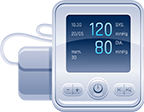
Blood Pressure Systolic (mmHg) Diastolic (mm Hg) Normal Less than 120 and Less than 80 Elevated 120-129 and Less than 80 High Blood Pressure
(Hypertension)130 or Higher or 80 or Higher Keeping Blood Pressure in Control
Your health care team can help you manage your blood pressure and lower your risk for complications. What changes could you make to control your blood pressure?

Take prescribed blood pressure medication.
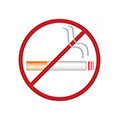
Decrease or quit commercial tobacco.
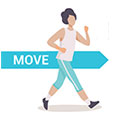
Move more. Even a 15-minute walk most days helps.

Eat more fruits and vegetables.
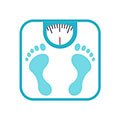
Aim for a healthy weight.

Get enough sleep.
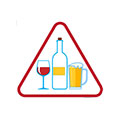
Limit alcohol to no more than 1 drink a day for women, 2 for men.
Fats and Heart Health
Diabetes Information for You and Your Family

Fat provides energy for the body. Native people hunted and harvested food like buffalo, seal, fish, nuts, and seeds that provided "good" fats. As food choices changed over the years, so have the kinds of fats we eat.
Today, our food includes more of the fats that may cause heart disease. Heart disease is more common among people with diabetes.
Share
Types of Fat
Saturated fats raise cholesterol levels, which is a risk for heart disease. Saturated fats are found in animal products and tropical oils. These fats are solid at room temperature.
Unsaturated fats can help lower LDL (bad) cholesterol and provide nutrition. They come from plant oils and fatty fish. Unsaturated fats are liquid at room temperature.
Good to know
- Fats have more calories than carbohydrates and protein. For example:
1 gram of fat = 9 calories.
1 gram of carbohydrate or protein = 4 calories. - Eating large amounts of fat can lead to weight gain.
Heart-Healthy Fat Choices
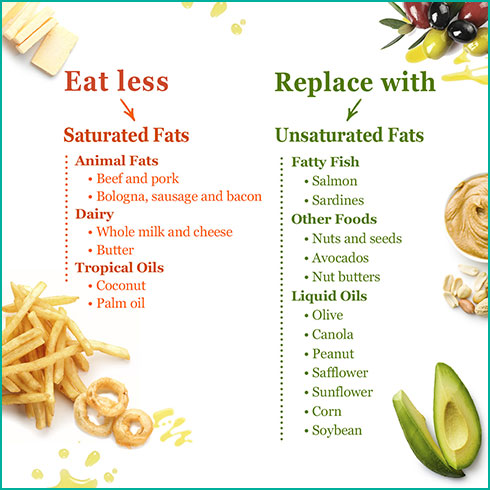
Limit foods high in
saturated fat.Use foods rich in
unsaturated fat in place of
foods high in saturated fat.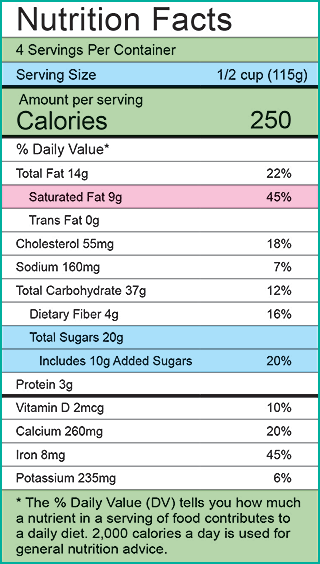
Nutrition Facts Label
The Nutrition Facts label can help you learn about nutrients in foods and drinks.
Saturated Fat
Look for the amount of saturated fat in grams (g) and the percent (%) Daily Value of saturated fat in a serving.
In this example, the grams of saturated fat is 9 g, and the Daily Value is 45% in this serving. For this food, the amount of saturated fat is high.
Eat less than 20 g saturated fat daily, and remember:
Low saturated fat means
- 1 g saturated fat or less per serving
- 5% daily value or less per serving
High saturated fat means
- 3.5 g saturated fat or more per serving
- 20% daily value or more per serving
More Ideas for Heart-Healthy Eating
- Eat plenty of fruits, vegetables, whole grains, low-fat dairy, poultry, fish, and nuts.
- Limit fatty red meat. Choose buffalo, moose, elk, deer, or caribou when you can.
- Eat fish twice a week. Salmon, sardines, and tuna contain “good” fats.
- Decrease how much salt you use. Check the Nutrition Facts label for the amount of sodium (salt) on packaged and fast foods. The recommended daily amount for sodium is 2300 mg.
- Limit sugary foods and drinks.
- Grill, stir fry, bake, boil, roast, or slow cook food

What about eggs?
Eggs are rich in protein and nutrients. They are low in saturated fat with 1 gram per egg. If you eat eggs, limit them to 7-12 eggs per week.
Keeping Your Heart Healthy
Diabetes Information for You and Your Family
Keeping your heart healthy and strong is important, especially if you have diabetes. By taking care of your heart, you can lower your chances of having heart disease.
Below are some things you can do to keep your heart healthy.
Share

Talk with your health care team about how to take care of your heart.
Blood pressure
- Ask what your goal should be for blood pressure.
- Many people with diabetes will need medicine to help them control their blood pressure.
Commercial tobacco
- If you smoke, chew, or dip commercial tobacco, ask for information on how to quit.
- Call 1-800-QUIT-NOW (1-800-784-8669) for free help.
- Avoid being around smoke from others using commercial tobacco.
Cholesterol
- Most people with diabetes will need to be on a type of medicine called a statin to lower their cholesterol.
- Ask if a statin is right for you.

Make healthy food and drink choices.
- Eat healthy foods, such as vegetables, fruits, beans, whole grains, fish, wild game, and other lean meats.
- Select foods that have less salt, fat, and sugar.
- Grill or bake instead of frying.
- Drink plenty of water.

Stay active.
- Any amount of physical activity is good.
- Try walking at least 3-4 times a week. Start with 5-10 minutes and work up to 30 minutes or more.
- Choose an activity you enjoy. Take a walk with family or friends. Go for a bike ride. Dance. Play ball. Work in the garden.

Find healthy ways to reduce stress.
- Take time to relax. Do something you enjoy, such as drawing, reading, crafts, or walking in nature.
- Talk with others about what may be causing stress for you.
- Find a support group at your Tribe, clinic, or community center.

Follow up with your health care team regularly.
Understanding Your Cholesterol
What is Cholesterol?
Cholesterol is a fat-like substance that helps your body build cells, vitamins, and hormones. Too much cholesterol in the blood can be harmful. It can increase the risk of a heart attack and stroke, especially in people with diabetes.
Share
View Handout [PDF – 1.6 MB]
Check Your Cholesterol Levels
This is done with a fasting blood test known as a lipid panel that measures cholesterol and triglyceride levels.
Knowing your cholesterol and triglyceride numbers helps you understand your risk for heart disease.
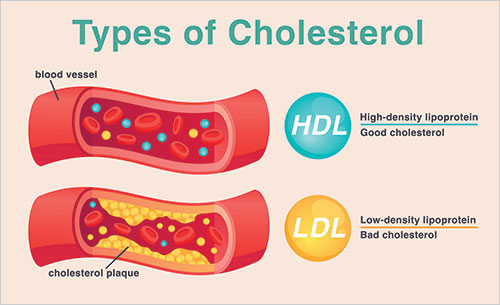
 HDL cholesterol is also known as “good cholesterol”. It helps to carry cholesterol so that it can be broken down and removed from the body. Higher levels of HDL lower the risk of heart disease.
HDL cholesterol is also known as “good cholesterol”. It helps to carry cholesterol so that it can be broken down and removed from the body. Higher levels of HDL lower the risk of heart disease. LDL cholesterol is also known as “bad cholesterol” because it can deposit in the wall of the blood vessels and reduce blood flow.
LDL cholesterol is also known as “bad cholesterol” because it can deposit in the wall of the blood vessels and reduce blood flow.Triglycerides are the most common type of fat in you blood and cells. They store energy in your cells from fats and sugars. A high triglyceride level is a risk factor for heart disease.
Total cholesterol is a measure of all the cholesterol in your blood.
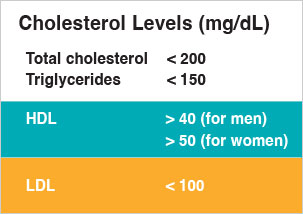
Recommendations
This table shows optimal cholesterol levels for most adults. However, levels are different for people with diabetes or those at increased risk of heart disease and stroke.
For people with diabetes and cardiovascular disease, the optimal LDL-cholesterol level is less than 70 mg/dL.
For more tips, view: Fats and Heart Health
Form Healthy Living Habits
Begin by making small, positive steps in your daily life.
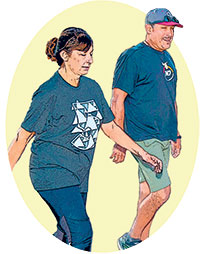
Heart Healthy Living
- Get regular exercise: 150 minutes/week.
- Lose weight if you are overweight. A 5–10 pound loss may lower blood fats.
- Limit intake of alcohol, if you drink.
- Quit smoking and vaping.
- Cholesterol medication may be needed to reach cholesterol goals.
Heart Healthy Eating Choices
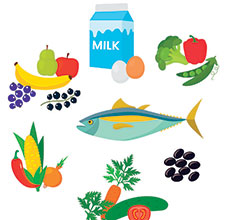
- Eat plenty of fruit and vegetables; choose a wide variety.
- Use healthier fats from plants: corn, canola, olive, soybean, peanut, sunflower and avocado oil.
- Choose healthy proteins: lean cuts of meat and poultry, buffalo, elk, wild-caught fish and game.
- Eat fish twice a week. Fish like salmon and sardines have heart-healthy omega-3 fatty acids.
- Eat less high fat dairy foods like whole milk, cream, and full-fat cheese.
- Eat less fatty meat like pork or beef ribs, sausage, and processed meat like bologna and hot dogs.
- Choose whole grains instead of refined grains like white bread and white rice.
- Avoid foods and drinks high in added sugar.
What Causes High Cholesterol?
- Genetics
- Diets high in saturated fats
- Not enough physical activity
- Having excess body fat
- Smoking
- Some medications
What Increases Triglycerides?
- Added sugar in foods/drinks
- Diets high in carbohydrates and low in fiber
- Alcohol intake in excess
- Being overweight or obese
- Diets high in fat
- Uncontrolled diabetes
Saturated fat comes from animal fat in dairy and meat and from tropical fats. Examples are solid fats like butter, lard and coconut oil.
For more tips, view: Cut Down on Saturated Fats [PDF]
Protecting Your Kidneys
When You Have Diabetes
In most cases, there are no symptoms of kidney problems. That is why it is important for people with diabetes to get their kidneys checked.
Take steps to protect your kidneys:
Share
 Get your kidneys checked every year.
Get your kidneys checked every year.Blood and urine tests are the only way to know how well your kidneys are working.
 Take care of your blood pressure and blood sugar.
Take care of your blood pressure and blood sugar.Did you know?

Frequent use of common over-the-counter medicines can harm your kidneys.
These include the following:
 Ibuprofen (Examples: Advil, Motrin, Midol)
Ibuprofen (Examples: Advil, Motrin, Midol) Naproxen (Examples: Aleve, Naprosyn)
Naproxen (Examples: Aleve, Naprosyn)Talk with your doctor about over-the-counter medicines you may be using.

Taking Diabetes Medicines
People with diabetes often need to take medicines to help keep blood sugar at a healthy level.
Share

Take your medicines as it says on the labels. Ask your medical provider about any concerns, such as:
- When to take medicine
- How much medicine to take
- What to do when your blood sugar is low
- What to do if you miss a meal
- What to do when you are sick
- What are common side effects

Refill your medicines before they run out.
Medicines can usually be refilled one week before they run out. Look at the labels on the medicines to check for refills. If there are no refills, contact your medical provider.

Let your medical providers know about all the medicines you take, as well as how much and how often you take them.
Below are some ways you can help keep your medical providers up to date:
Take all your medicines with you to each medical visit.
Keep a list of all your medicines. Get a list from your pharmacy or make your own.
Use your cell phone to snap a picture of each medicine label to show your medical providers.
Remember to include other things you take, such as over-the-counter medicines, vitamins, and supplements.
Tips to Help You Remember to Take Medicines

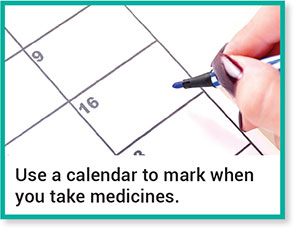
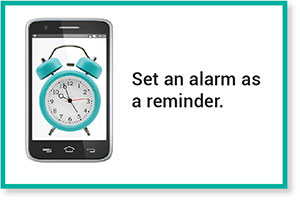
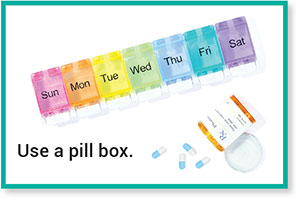
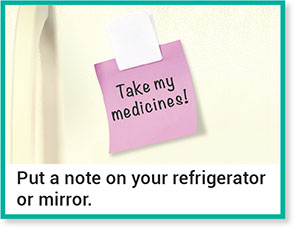
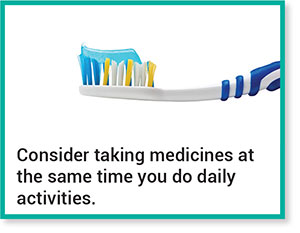
Be Safe with Medicines
- Keep all medicines out of the reach of children.
- Sharing medicines can be harmful. Only take medicines prescribed for you.
- Talk to your medical provider before you stop taking any of your medicines.
- Ask your health care team how to safely:
- Store medicines
- Get rid of unused medicines
- Dispose of used needles and syringes
Carbohydrates by Color
Carbohydrates are your body’s main source of energy
Carbohydrates (carbs) come from sugars, starches, and dietary fiber. They are part of a healthy diet. For most people, carbs are the body’s leading energy source and affect blood sugar.
How much and what carbs you eat affects how high and quickly your blood sugar rises.
To keep it simple, you can use colors—colorful, brown, and white—to identify carbs. Some carbs are healthier than others. Carbs with deeper or brighter colors are usually more nutritious than paler, more processed carbs, such as foods made with white flour and sugar.
Share
Colorful Carbs
Starchy Vegetables
Starchy vegetables add color and texture to meals. They are healthy substitutes for highly processed grains, such as white flour and white rice. Native people traditionally ate a wide variety of corn, beans, squash, and root vegetables.
These vegetables are naturally high in fiber and nutrients. They raise blood sugar more slowly than the more processed carbohydrates.
Try to eat at least 5 cups of starchy vegetables every week.
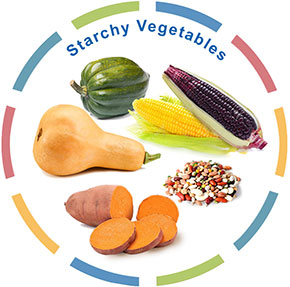
Fruit
Fruit is a colorful carbohydrate which is low in fat and calories. The sweetness you taste when eating fruit is from the natural sugar in it. Although fruit has carbohydrates, it is low in fat and calories.
Fruits may be fresh, frozen, canned, or dried. Fruit is a good source of nutrients: potassium, folate, vitamin C, and fiber.
Try to eat 2 to 3 servings of fruit each day—such as a cup of berries and a small apple, or 2 tablespoons of raisins.
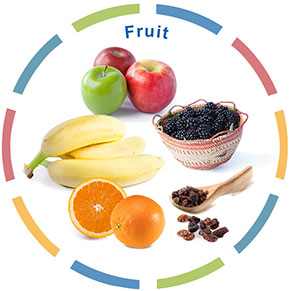
Brown Carbs
Whole Grains
Whole grains are usually brown. They come in many shapes and textures and are a major energy source. Whole grains include whole wheat flour, brown and wild rice, rolled oats, and corn meal. Some breads and pastas are made with whole grain.
Whole grain foods are full of fiber and raise sugar more slowly than processed grains. They are less likely to cause spikes in blood sugar.
Make half your grain choices whole grains.
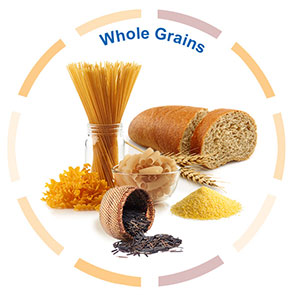
White Carbs
Processed Grains and Sugars
Processed grains and sugar are usually white. Foods made from these tend to raise blood sugar quickly and could contribute to it going too high.
Food made with white flour includes crackers, white bread, flour tortillas, fry bread, and instant noodles.
Choose white carbs less often.
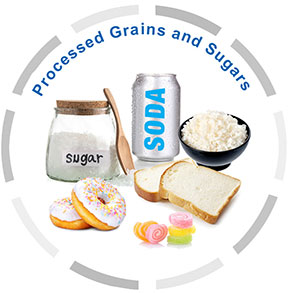
Dairy Foods
Dairy foods are rich in essential nutrients: calcium, phosphorus, vitamin D, and protein. Many dairy foods have carbs along with protein and fat. They can be part of a healthy diet.
Aim for 3 servings of dairy foods each day.
Low Carbs or No Carbs
Foods with low or no carbs have very limited or no effect on blood sugar levels. Some foods with few or no carbs include:
- Meats, fish, eggs, and cheese
- Non-starchy vegetables, such as tomatoes, onions, green beans, carrots, cabbage, celery, lettuce, and peppers
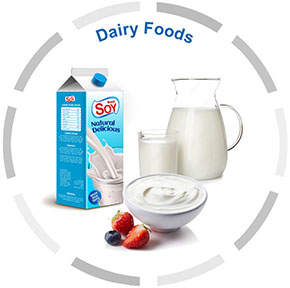
Put into practice what you’ve learned:
Find the Carbohydrates on My Native Plate
For use with Carbohydrates by Color Fact Sheet
Knowing which foods have carbohydrates (carbs) is one of the first steps to choosing healthy foods. Use the four plates shown to practice finding carbs.
(See answers below.)Share
- Find the grains and starches using the color shades of white, brown, and colored foods on the plates.
- Find the other brightly colored carbs. (Hint, they are naturally sweet.)
- Find the foods that have low carbs or no carbs.
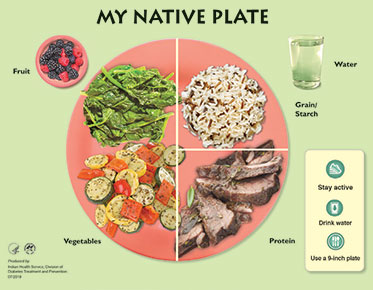
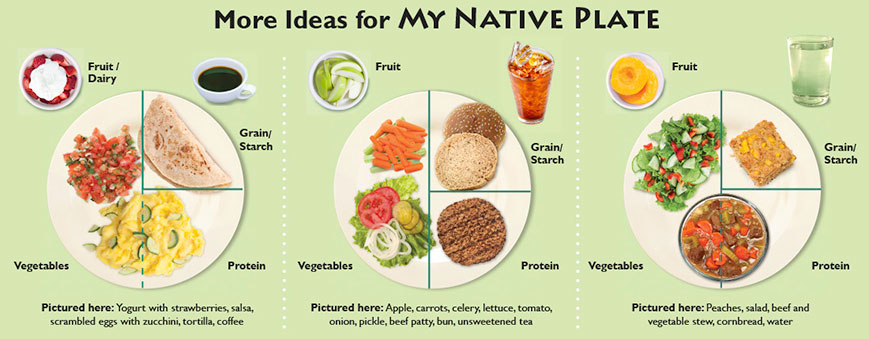
Helpful Tips
- Try choosing healthier carbs for meals and snacks. Balance the carbs you eat throughout the day.
- Eating the right kinds and amounts of carbs can help with blood sugar control.
- For more on understanding carbohydrates:
- Visit a Dietitian or Diabetes Care Specialist for an eating plan specifically for you. They can help you learn how many carbs are right for you.
- This worksheet is a companion material to the Carbohydrates by Color fact sheet.
Answers to finding the carbs on My Native Plate
- Answer: rice, tortilla, hamburger bun, cornbread
- Answer: berries, apple slices, canned peaches
- Answer: meat, egg, non-starchy vegetables: salad, carrots, celery, tomato, zucchini, and greens
Healthy Eating on a Budget
Diabetes Information for You and Your Family
Did you know?
Healthy eating is an important part of managing diabetes. Eating healthy doesn’t mean you need to buy costly foods. Many of the foods you already prepare for yourself and your family are healthy.Share
What are healthy foods?
 Foods in a more natural state
Foods in a more natural state Fresh, grown, and gathered foods
Fresh, grown, and gathered foods Foods low in sodium and added sugars
Foods low in sodium and added sugars Fruits and vegetables—fresh, frozen, or canned
Fruits and vegetables—fresh, frozen, or canned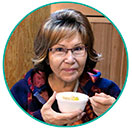
Examples include:
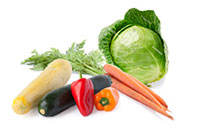
Vegetables:
Carrots, leafy greens, peppers, squash, onions
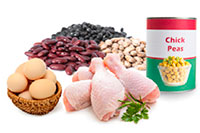
Proteins:
Beans, eggs, meat, fish, poultry, nuts
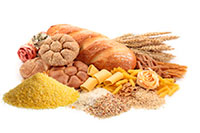
Whole Grains:
Whole grain corn meal, bread and pasta, wild and brown rice, oats
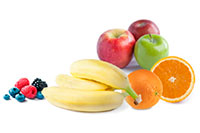
Fruits:
Apples, bananas, oranges, berries
Ways you can eat healthy and save money
 Plan your meals
Plan your meals- Think about the foods that your family enjoys. Start planning with one meal, such as dinner.
- Start by writing your meal ideas down
- Consider using a Weekly Meal Plan.
- Plan easy-to-make meals for when you won’t have a lot of time.
 Make a grocery list
Make a grocery list- Keep an ongoing list of foods you need.
- Check to see which foods you have on hand.
- Limit adding costly processed foods such as chips, cookies, donuts, soda pop, and packaged meals.
 Plan your shopping trip
Plan your shopping trip- Take a freezer bag or cooler if you are far from home.
- Check the store ads for sales. Join the store’s loyalty program for offers and discounts.
- Eat before you shop. It helps you stick to your list.
 Save money while you shop
Save money while you shop- Look for in-store markdowns.
- Buy store brands. They taste similar to name brands, but cost less.
- Buy fruits and vegetables in season. See - Seasonal Produce Guide.
 Cook at home
Cook at home- Eat healthier and save money by cooking at home.
- Cook traditional foods with family to celebrate culture.
Helpful Tips
- Buy healthy foods in bulk. Divide into servings and store.
- Rinse canned vegetables to remove added salt.
- Frozen and canned vegetables are easy to add to meals.
Getting enough healthy foods
Sometimes it may be hard to get enough healthy food. Consider a family garden, joining a community garden, hunting, or gathering what you can from the land and water.
Learn about nutrition assistance programs. Your healthcare team may know about food support options such as:
- Food pantries and/or farmer’s markets.
- Federal Food Assistance Resources.
- USDA National Hunger Hotline:
1-866-3-HUNGRY (1-866-348-6479)
Healthy Recipes
Get Fresh! Cooking – Recipes from the Chickasaw Nation and USDA.
MyPlate Kitchen Recipes – Videos, seasonal recipes, food safety and more. Diabetes Food Hub Diabetes– Friendly recipes from the American Diabetes Association.
Spend Smart-Eat Smart – Ways to cut food costs. Iowa State University Extension & USDA.
 Sample Grocery List
Sample Grocery List- Vegetables
- Fruits
- Wild or brown rice
- Whole grain cereals and breads
- Eggs
- Beans
- Chicken or turkey
- Fish
- Beef or Pork – leaner cuts: round and loin
Limit Added Sugar
Sugar in food can occur naturally or can be added. Sugars (simple carbohydrates) are digested quickly and change to glucose as fuel for the body. Too much sugar is not good for you.

Natural Sugar
Natural sugar is in fruits and naturally sweetened fruit juices, milk, and some vegetables.
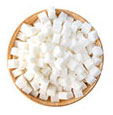
Added Sugar
Added sugars are syrups and sugars that are added to foods and drinks during preparation, processing, or at the table.
Share
Too much added sugar may contribute to health problems such as,
weight gain, obesity, and diabetes.
Eating large amounts of added sugar may make it difficult to get all the daily nutrients your body needs and may cause you to consume too many calories.
Major Sources of Added Sugar
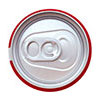
Sugar Sweetened Drinks
Sodas & Soft Drinks
Teas & Coffees
Energy & Sport Drinks
Powdered Drink Mixes
Fruit Drinks
Desserts
Cupcakes & Muffins
Cakes & Pies
Ice Cream
Cookies & Donuts
Candy
Sweet Breakfasts
Sweet Cereals
Cereal Bars
Pastries
Pancakes with Syrup
Flavored Yogurt
Syrups and Sweets
Jams
Jellies
Chocolate Syrup
Honey
MolassesReducing Added Sugar
- Choose sugary foods and drinks less often.
- Have smaller servings of sugary foods or drinks.
SWAP THIS

- Sodas, sports and energy drinks
- Sweet desserts
- Candy bar
- Cookies
- Sweetened cereals
FOR THAT

- Fruit infused water or tea
- Fresh fruit or frozen fruit pops
- Smoked salmon or dried meat
- Peanut butter with celery
- Blue corn mush or cereals with less than 3 grams (g) sugar
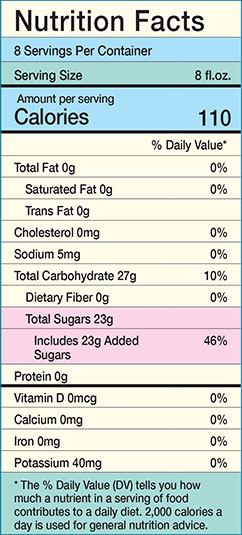

Let the Nutrition Facts Label Be Your Guide
Check the label to see if foods are LOW or HIGH in added sugars.
- 5% Daily Value or less is LOW in added sugar
- 20% Daily Value or more is HIGH in added sugar
 In this example, the added sugar is 23 grams, and the Daily Value is 46%. This food is high in added sugar.
In this example, the added sugar is 23 grams, and the Daily Value is 46%. This food is high in added sugar.The Daily Value for added sugars is 10% of total calories per day.
 For example, if your daily food intake is about 2,000 calories, this would be 50 grams of added sugars.
For example, if your daily food intake is about 2,000 calories, this would be 50 grams of added sugars.My Native Plate
Use your plate as a guide to help you eat in a healthy way!
 Fill half your plate with vegetables
Fill half your plate with vegetables Fill the other half of your plate with a grain/starch and a protein.
Fill the other half of your plate with a grain/starch and a protein. Add a side of fruit
Add a side of fruitShare
Picture here:
- Mixed berries
- Cooked spinach
- Baked squash with peppers and herbs
- Steamed wild rice
- Baked deer meat with sage
- Water
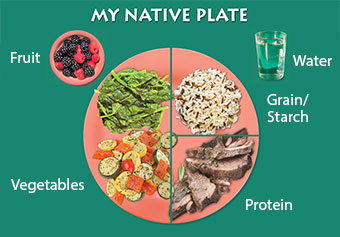
Remember:

Stay Active

Drink Water

Use a 9-inch plate
More Ideas for My Native Plate
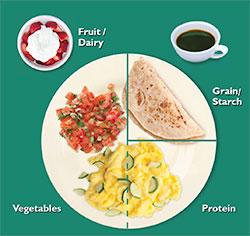
Pictured here: Yogurt with strawberries, salsa, scrambled eggs with zucchini, tortilla, coffee
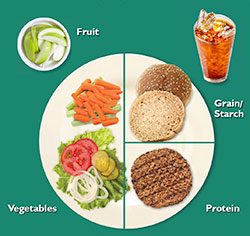
Pictured here: Apple, carrots, celery, lettuce, tomato, onion, pickle, beef patty, bun, unsweetened tea
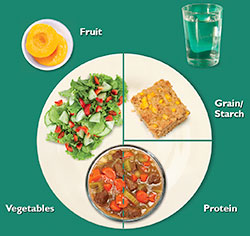
Pictured here: Peaches, salad, beef and vegetable stew, cornbread, water
Ways to Add Variety to Meals and Snacks
Vegetables and Fruits
Tips
- Stock up on fresh, frozen, and canned vegetables and fruits.
- Keep fruits and vegetables on hand for snacking.
- Plan some meals around a vegetable main dish, such as a stir fry, stew, or soup.
- Enjoy fruit as a dessert.
Examples
Vegetables: Wild greens, tomatoes, carrots, leafy greens, zucchini, avocados, broccoli, green beans, cucumbers, onions, peppers, okra
Fruits: Berries, melons, apricots, peaches, citrus fruits, bananas, apples, pears,
Proteins
Tips
- Choose fish, beans, lentils, eggs, and nuts more often to cut down on meat.
- Instead of a beef patty for your burger, try a veggie, black bean, turkey, soy, or bison patty.
- Grill, stew, or bake meat instead of deep frying.
- If milk upsets your stomach, try yogurt, lactose free milk, or soy milk.
Examples
Animal proteins: Fish, wild game, bison, poultry, mutton, beef, pork, eggs,
Plant proteins: Beans, lentils, nuts, nut butters, seeds, tofu, soy products, Dairy proteins: Milk, lactose free milk, yogurt, cheese, cottage cheese,
Grains and Starches
Tips
- Choose whole grain foods, such as whole wheat breads, corn tortillas, oatmeal, and wild or brown rice.
- Try whole wheat flour instead of white flour.
- Add wild or brown rice to main dishes, such as a stir fry, stew, or soup.
- Bake or roast potatoes instead of deep frying.
Examples
Grains: Pastas, breads, crackers, rice, oats, quinoa, barley, cereals, tortillas, flour, cornmeal,
Starchy vegetables: Potatoes, corn, green peas, winter squash,
Related Materials
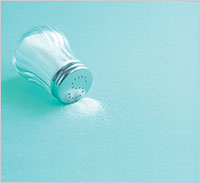
Sodium and Your Health
Sodium is a mineral that our body needs in small amounts to keep our fluids balanced. Typically, we get it in the form of salt. Most people get more sodium than their bodies need. If you have kidney disease, high blood pressure, or heart disease, ask your health care provider what the right amount of sodium is for you.
Share
View Handout [PDF – 2.6 MB]
Where is sodium in food?
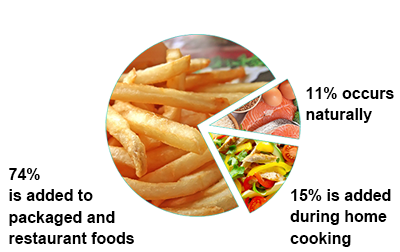
Reducing sodium can help lower your blood pressure and reduce your risk for heart disease, stroke, and kidney disease.
What about salt substitutes?
Potassium chloride is a common salt substitute. Talk with your provider before using a salt substitute. People with kidney disease are at risk for having potassium levels either too high or too low.
Ways to Reduce Sodium

- Look for foods labeled “No Added Salt,” “Low Sodium,” “Reduced Sodium,” and/or “Lightly Salted.”
- Eat more fruits and vegetables.
- Prepare meals with low sodium ingredients.
- Rinse canned vegetables, meat/fish, and beans to remove some of the sodium.
- Prepare traditional foods with less or no salt.
- Eat a smaller portion of a high sodium food or have it less often.
- Use herbs, spices, and sodium-free seasonings in place of salt.
- Look for hidden sources of sodium in sports and energy drinks, vegetable juice, and cottage cheese.
Sodium impacts people with kidney disease
Kidney disease is when your kidneys are damaged and have difficulty removing sodium from the body. This may raise blood pressure and cause water retention. Talk with your provider about the right blood pressure goal for you.
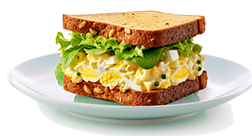
A deli or bologna sandwich can be high in sodium. Choose a low sodium food like egg salad, or peanut butter and jelly
Ideas for Reducing Foods High in Sodium
Makes changes slowly and your taste will adjust to having less salt.

Swap This
Packaged and Restaurant Food
Cured meat
- Sausage and bacon
- Ham, hot dogs, and deli meat
Soups
- Canned or instant noodles
- Broth or boullion
Instant Meals
- Flavored rice and noodles
- Pancage or muffin mixes
- Canned stews
- Frozen meals like pot pies
Snacks
- Chips, pretzels, and crackers
- Salted nuts and seeds
Fast food and restaurant meals
- Pizza, burgers, and fries
- Pastas, tacos, and more
For That
Fresh and Low Sodium Food
Fresh meat
- Bison, elk, deer, moose, and caribou
- Lean beef, poultry, or seafood
Soups from scratch
- Made with low sodium ingredients
- Homemade broth
Grains
- Rice and pasta
- Hot cereal without salt
Snacks
- Home popped popcorn
- Unsalted nuts and seeds
Other homepage meal ideas
- Wraps or sandwiches made with leftover meat or eggs
- Omelet with veggies and herbs
- Chili and stews

Read the Nutrition Facts label.
Compare and choose foods with the lowest Percent Daily Value for sodium: 5% is low and 20% is high.*
What is the daily sodium limit?
The recommended daily limit for most adults is 2,300 mg of sodium, which is about 1 teaspoon of salt from all foods and drinks. On average, people in the U.S. get 3400 mg per day, or 50% higher than the adult limit.

Try the DASH Eating Plan,
proven to help lower blood pressure. Learn more at,
DASH – Dietary Approach to Stop HypertensionLooking for healthy recipes low in sodium?
See My Plate.gov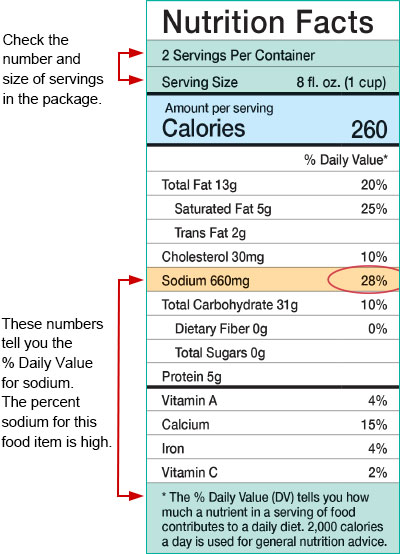
Keeping Your Teeth and Gums Healthy When You Have Diabetes
People with diabetes have a higher chance of having teeth and gum problems. This is why it is important to manage your blood sugar and take care of your teeth and gums.
Share
Ways to take care of your teeth and gums:

Brush your teeth twice a day.
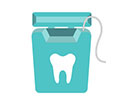
Floss your teeth each day.

Get a dental exam at least once a year.
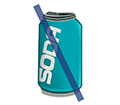
Avoid foods and drinks that are high in sugar.
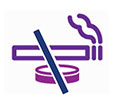
Do not use commercial tobacco, including smokeless and chewing tobacco.
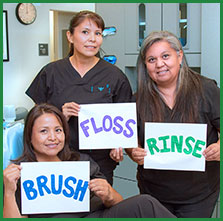
Let your health care team know if you have any of these problems:
- Red or swollen gums
- Pain when chewing
- Loose and shifting teeth
- Bad breath that does not go away
- Sore or bleeding gums when brushing or flossing
How To Get Started Walking
Diabetes Information for You and Your Family
Why walk?
Our bodies are meant to get up and walk—to the mailbox, down the road, around the neighborhood.
Share
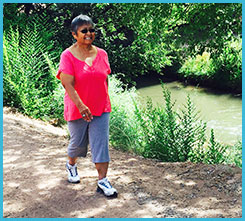
“I started walking so I will be healthier and less stressed. I want to be there for my family for a long time.”
Gloria Anico,
Kickapoo / Seminole Tribes, OklahomaWalking can help you stay healthy and live longer so you can:
- Be there for your children, grandchildren, and other family members.
- Be an active and helpful member of your community.
- Serve as an Elder and share your wisdom.
All you need is a sturdy pair of shoes, a few minutes, and a safe place to walk. Give walking a try!
How does walking help?
Walking helps your mind, body, spirit, and emotions. It can help you:
- Have more energy by keeping your blood sugar, blood pressure, cholesterol, and weight in good ranges.
- Stay active and prevent injuries by keeping your muscles and bones strong.
- Feel calmer and less stressed by lifting your spirits.
Is walking right for you?
Walking is right for most people. If you are not sure that walking is right for you, ask your health care provider:
- Is walking right for me?
- How much walking is right for me?
- Do I need to check my blood sugar before and/or after I walk?
How can you get started?
Start slowly. You may be able to walk only a few minutes at first. That’s okay. Try these tips for getting started:
- Walk at your own pace.
- Walk up and down your driveway or around your home.
- Walk around while you watch TV or talk on the phone.
- Park a little farther from the store.
Try to build up to walking 3 to 5 minutes, 2 or 3 times a day. With time, you may be able to walk farther and go faster. Keep track of the minutes you walk. You may even find that you feel better and stronger.
What may keep you from walking?
There are many reasons people do not walk:
- They feel they are too busy.
- They feel tired, sad, or sluggish.
- They feel out of shape or have aches and pains.
- They feel shy about walking. They may worry that people will think they are showing off.
- All of these feelings are common. With a little time, and by walking a few minutes each day, these feelings often pass.
- Remember: You are walking not just for yourself, but to be there for the people you love.
Imagine looking forward to your walks.
- Picture walking as an inspirational part of your day – a special time either alone or with others.
- Be thankful while walking. Give thanks to the people who have gone before you. Be grateful for your body, your family, and friends.
- Enjoy the outdoors. Walk in the woods, along a dirt path, in a park, or by the ocean.
- Make it family time with your children or grandchildren.
- Walk with friends. Find a walking partner or two. Laugh and have fun.
Today is a good day for a walk!
By starting to walk, you are taking care of your diabetes so you can be there for your family and your community.
How To Walk Farther and Faster
Diabetes Information for You and Your Family
Why walk more?
You are already walking and that’s great! By walking more, you are taking steps to stay healthy and live longer so you can:
- Be there for your children, grandchildren, and other family members.
- Be an active and helpful member of your community.
- Serve as an Elder and share your wisdom.
Share
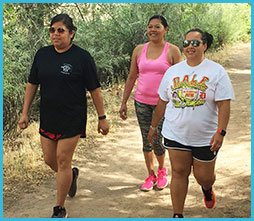
“Walking with a group of friends or family is a great way to stay on track.”
Katie Wilson (right)
Choctaw / Creek Tribes, OklahomaHow much do you need to walk?
To take care of your diabetes, build up to walking at least 30 minutes on most days of the week. Keep track of the number of minutes you walk each day.
- If you cannot walk 30 minutes all at once, try walking 3 times a day for 10 minutes.
- Listen to your body. Some days you may feel like you can walk longer. Other days you may need to take it easier.
- Keep up a good pace. A good pace is when you can talk while you walk without running out of breath. If you can sing while you walk, you may want to walk faster.
- Try to walk a little farther and faster each week
How do you keep going?
- Choose the days and times that you are most likely to walk. Some people set aside the same time every day for their walks.
- Walk when you have the most energy or when the weather is the nicest.
- Make it family time with your children or grandchildren.
- Walk with friends. Find a walking partner or two. Laugh and have fun.
What if you have health concerns?
- Check with your health care provider about your plan to walk more. Talk about any pain you have when you walk.
- If you have chest pain, nausea, or shortness of breath, these may be signs of a serious health problem. Call a health care provider right away.
What if you miss a few days?
If you miss a few days of walking, don’t be hard on yourself or give up. Things happen in life.
- Are you stressed or too busy?
Set aside time to take a few short walks. - Do you feel sore?
Stretching can help you move and feel better. - Is the weather bad?
Walk indoors—in your home, at a store, or at a wellness center.
Start back up when you can. Build slowly toward your goal.

“I walk during the middle of my day. Walking gives me energy. It helps get rid of stress so I feel better.”
Carmela Ramirez,
Kickapoo Tribe, OklahomaHow can you protect your feet?
- Wear shoes that fit well and that cushion and support your feet.
- Avoid wearing shoes that rub your feet, toes, or heels.
- Wear a clean pair of socks that are not too tight and that keep your feet dry.
- Check your feet every day for blisters, sores, redness, or swelling. If you find any of these, call your health care provider right away.
What are some safety tips?
- Choose a safe place to walk.
- Take a cell phone with you.
- Take water with you.
- Take glucose tablets or a few pieces of sugar-sweetened hard candy in case your blood sugar gets low.
Walk your way to a healthy future!
By walking, you are taking care of your diabetes so you can be there for your family and your community.
Being Active is Traditional
For generations, Native people have lived active lives: growing crops, hunting, fishing, and gathering berries, herbs, and traditional medicines. Cultural ways are active, such as dancing, running, drumming, carving, and playing games. Being active improves mental and spiritual well-being—it is good medicine.
Movement helps muscles use sugar for energy, which may improve blood sugars. Any increase in movement is good for you.
Share
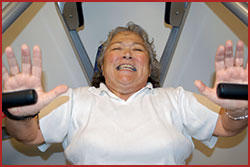
Melva, doing a chest press at the gym.
I learned that exercise could mend this old body. I found out that exercise is the key. I found out I can control diabetes. I am the person who has to take care of my body. It is up to me to stay well. It’s so simple.
Why be active?
- Feel less stress and have a happier mood.
- Increase strength, balance, and flexibility.
- Improve blood sugar, blood pressure, and cholesterol levels.
- Achieve or maintain a healthy weight.
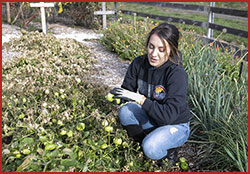
How to get started
- Talk with your health care team about what is safe and best for you.
- Set a day and time for your activity, and write it on your calendar.
- Ask a friend to join you.
- Plan indoor and outdoor activities.
Fun ways to get moving
- Gardening, gathering berries and greens, and doing yardwork.
- Yoga and tai chi for balance and flexibility.
- Brisk walking, hiking, jogging, swimming and bike riding.
- Fitness classes and strength training.
- Chair exercises and arm movements.
- Do what you enjoy!
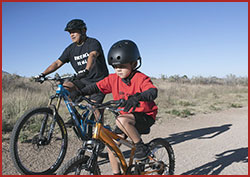
How much activity to do
If you miss a few days of walking, don’t be hard on yourself or give up. Things happen in life.
- Start slowly, even if it is 5 or 10 minutes a day, and build up from there.
- If sitting a lot, try to get up and move every 30 minutes.
- Try to increase your activity to 150 minutes a week, over three or more days.
Be safe when being active
- Choose a safe place. If you have a cell phone, take it with you.
- Check blood sugar before and after exercise. If less than 100, eat a food or drink with sugar, such as, a half cup of juice, or small fruit, or a few pieces of hard candy. For more information see, Low Blood Sugar.
- Bring water and stay hydrated.
- Bring hard candy (not sugar-free) or glucose tablets in case your blood sugar drops too low while being active.
- Warm-up and cool down. Go at a slower pace at the start and end of your activity.
- Wear comfortable shoes. Check your feet for sores, cuts, blisters, corns, or redness before and after exercise, as well as daily. Let your provider know if you find any of these.

Take care of yourself and your spirit
Any increase in movement is good for you. Even adding chair exercises or arm movements helps you to be more active.
You may start with a slow walk at first. The more you do it, the farther you can walk and the stronger you will get. For more information see, How to Get Started Walking.
Being active often brings peace and a feeling of pride. Your family will see how hard you have been working and how it is helping to manage your diabetes. They will be proud of you too!
Move More – Sit Less
Sitting for more than 7-8 hours a day at home or in the office can decrease muscle strength and increase the risk of diabetes and blood clots over time. Reduced sitting time has benefits even for those who are physically active.
Share
View Handout [PDF – 1 MB]

Moving More
- Helps lower blood sugar levels for people with diabetes
- Helps boost circulation and increase muscle strength
- Reduces stress and improves mental health
- Improves quality of life
Interrupt sitting every 30 to 60 minutes
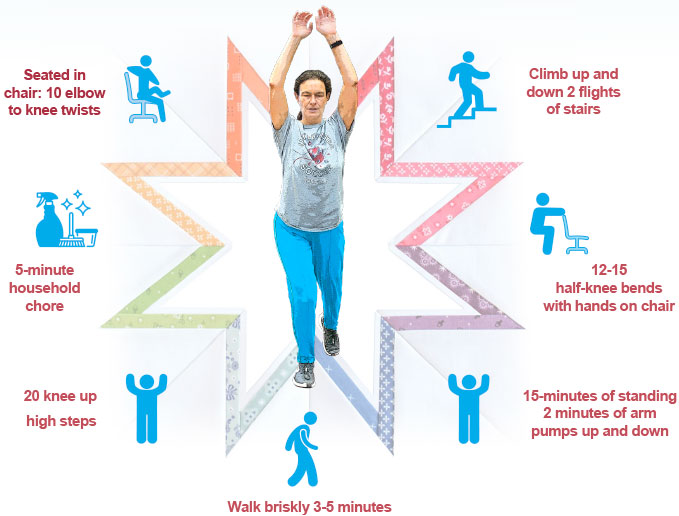
-
Displaying 1-25 of 121 products Listed for all audiences in all topics.
Glucose Management in Type 2 Diabetes Medications
Clinicians may use this tool as a quick reference to treatment algorithms based on national guidelines and the Diabetes Standards of Care and Resources for Clinicians and Educators.
Download Now! [PDF – 201 KB]- Topic
- Blood Glucose
- Medication
- Audience
- Health Care Professionals
- Format
- Algorithm
Move More - Sit Less
Prolonged sitting time can adversely affect our health. Interrupt sitting time and move more with these seven tips to keep your body moving.
Options:
- Read and Share
- Download Now! [PDF – 1 MB]
- Topic
- General Diabetes
- Health Promotion
- Physical Activity/Exercise
- Audience
- Health Care Professionals
- Patients/Clients
- Format
- Self-print
Understanding Your Cholesterol
This tip sheet reviews the types of cholesterol and their associated health risks and recommended levels. The infographic on page 2 has tips on forming heart-healthy living habits.
Options:
- Read and Share
- Download Now! [PDF – 1.6 MB]
- Topic
- Health Promotion
- Heart
- Audience
- Health Care Professionals
- Patients/Clients
- Format
- Self-print
Sodium and Your Health
Learn how sodium (salt) impacts your health and ways to reduce how much you consume. This factsheet reviews sodium recommendations and how to use the Nutrition Facts label to choose foods lower in sodium.
Options:
- Read and Share
- Download Now! [PDF – 2.7 MB]
- Topic
- Blood Pressure
- Health Promotion
- Heart
- Nutrition
- Audience
- Elders
- Health Care Professionals
- Patients/Clients
- Program Staff
- Format
- Self-print
Continuous Glucose Monitoring
Learn how Continuous Glucose Monitors (CGMs) help people with diabetes understand their blood sugar patterns so they can achieve improved diabetes control.
Options:
- Read and Share
- Download Now! [PDF – 2.6 MB]
- Topic
- Blood Glucose
- General Diabetes
- Audience
- Elders
- Health Care Professionals
- Patients/Clients
- Program Staff
- Format
- Self-print
Diabetes Screening and Prevention
Clinicians may use this tool as a quick reference to treatment algorithms based on national guidelines and the Diabetes Standards of Care and Resources for Clinicians and Educators.
Download Now! [PDF – 157 KB]- Topic
- Diabetes Prevention
- General Diabetes
- Health Promotion
- Audience
- Health Care Professionals
- Format
- Algorithm
Stress and Diabetes
Stress and Diabetes tip sheet offers ideas for how to deal with stress for improved blood sugar control and overall well-being.
Options:
- Read and Share
- Download Now! [PDF – 1.7 MB]
- Topic
- Behavioral Health
- Diabetes Prevention
- General Diabetes
- Health Promotion
- Audience
- Elders
- Health Care Professionals
- Patients/Clients
- Program Staff
- Format
- Self-print
- Tear-off Pad
Diabetes and Emergencies
Learn to prepare for an emergency situation that may require you to move to safety. Tip sheet discusses how to prepare a basic supply kit and make an emergency plan.
Options:
- Read and Share
- Download Now! [PDF – 1.4 MB]
- Topic
- General Diabetes
- Audience
- Elders
- Patients/Clients
- Program Staff
- Format
- Self-print
- Tear-off Pad
Checking Your Blood Sugar
This fact sheet is for people with diabetes who are new to using a glucose meter. Learn the basics about testing, such as when to test, target numbers, recognizing high and low blood sugars, and managing your diabetes.
Options:
- Read and Share
- Download Now! [PDF – 1 MB]
- Topic
- Blood Glucose
- General Diabetes
- Audience
- Health Care Professionals
- Patients/Clients
- Format
- Self-print
- Tear-off Pad
Limit Added Sugar
Learn about added sugars and the risks of consuming too many. The featured Nutrition Facts label shows users how to find added sugars and set daily limits.
Options:
- Read and Share
- Download Now! [PDF – 1.3 MB]
- Topic
- Diabetes Prevention
- Health Promotion
- Nutrition
- Weight
- Audience
- Health Care Professionals
- Patients/Clients
- Format
- Self-print
- Tear-off Pad
Blood Pressure and Diabetes
Learn what high blood pressure (hypertension) is and how it can be controlled.
Options:
- Read and Share
- Download Now! [PDF – 1.7 MB]
- Topic
- Blood Pressure
- General Diabetes
- Heart
- Kidney
- Nutrition
- Audience
- Elders
- Health Care Professionals
- Patients/Clients
- Program Staff
- Format
- Self-print
- Tear-off Pad
Find the Carbohydrates on My Native Plate
Knowing which foods have carbohydrates (carbs) is one of the first steps to choosing healthy foods. This fact sheet is for use with Carbohydrates by Color Fact Sheet.
Options:- Read and Share
- Download Now! [PDF – 618 KB]
- Order tear-off pad of 50 sheets
- Topic
- Nutrition
- Audience
- Health Care Professionals
- Patients/Clients
- Program Staff
- Format
- Self-print
- Tear-off Pad
Carbohydrates by Color
To keep it simple, you can use colors--colorful, brown, and white--to identify carbs. Use this fact sheet to help your patients/clients identify carbs by color.
Options:
- Read and Share
- Download Now! [PDF – 1 MB]
- Order tear-off pad of 50 sheets
- Topic
- Nutrition
- Audience
- Health Care Professionals
- Patients/Clients
- Program Staff
- Format
- Self-print
- Tear-off Pad
Fats and Heart Health
The types of fat we eat make a difference. Learn how to make heart-healthy fat choices using this colorful 2-page fact sheet.
Options:
- Read and Share
- Download Now! [PDF – 1.2 MB]
- Order tear-off pad of 50 sheets
- Topic
- Health Promotion
- Heart
- Nutrition
- Audience
- Elders
- Health Care Professionals
- Patients/Clients
- Format
- Self-print
- Tear-off Pad
Being Active is Traditional
This fact sheet reminds readers that being active has always been central to the heritage of American Indians and Alaska Native people. Get started, have fun, and enjoy the many health benefits outlined in this helpful guide.
Options:
- Read and Share
- Download Now! [PDF – 1.3 MB]
- Order tear-off pad of 50 sheets
- Topic
- Diabetes Prevention
- Physical Activity/Exercise
- Audience
- Patients/Clients
- Format
- Self-print
- Tear-off Pad
Diabetes and Pregnancy
New 2-page fact sheet offers information and tips on how to manage diabetes during and after pregnancy. Read and/or print for yourself, your family, or your patients!
Options:
- Read and Share
- Download Now! [PDF – 804 KB]
- Order tear-off pad of 50 sheets
- Topic
- General Diabetes
- Pregnancy
- Audience
- Patients/Clients
- Format
- Self-print
- Tear-off Pad
Healthy Eating on a Budget
Healthy eating on a budget encourages engaging with food through meal planning, food shopping, food savings, and cooking. Links to recipes and food assistance resources included.
Options:
- Read and Share
- Download Now! [PDF – 1.3 MB]
- Order tear-off pad of 50 sheets
- Topic
- Diabetes Prevention
- Health Promotion
- Nutrition
- Audience
- Patients/Clients
- Format
- Self-print
- Tear-off Pad
Diabetic Eye Disease
This 2-page easy to read handout describes diabetic eye disease and the importance of having an eye exam every year to prevent or slow eye disease.
Options:
- Read and Share
- Download Now! [PDF – 1.4 MB]
- Order tear-off pad of 50 sheets
- Topic
- Eyes
- Audience
- Elders
- Health Care Professionals
- Format
- Self-print
- Tear-off Pad
A River Runs Through Us 90-Day Journal for Wellness – Updated 2020
This 256-page full-color journal features photos and quotes from Tribal community members. It includes daily messages, a section to identify feelings and thoughts, and a place to track your self-care activities on your wellness journey. Let the words inside you be your guide to good health of mind, body, and spirit.
If you are hosting a class or event for American Indian/Alaska Native people and would like to request more than the posted quantity limit, please call 1-844-447-3387 or email diabetesprogram@ihs.gov.- Topic
- Behavioral Health
- General Diabetes
- Audience
- Elders
- Health Care Professionals
- Patients/Clients
- Program Staff
- Format
- Book
Protecting Your Kidneys When You Have Diabetes
Handout describes why it is important for people with diabetes to get their kidneys checked.
Options:
- Read and Share
- Download Now! [PDF – 462 KB]
- Order tear-off pad of 50 sheets
- Topic
- Blood Glucose
- Blood Pressure
- General Diabetes
- Kidney
- Medication
- Audience
- Health Care Professionals
- Patients/Clients
- Program Staff
- Format
- Self-print
- Tear-off Pad
Taking Diabetes Medicines
This two-page handout offers numerous ideas about taking diabetes medicines, including ways to keep health care providers informed, ways to remember to take medication, and tips on being safe with medicines.
Options:
- Read and Share
- Download Now! [PDF – 1.6 MB]
- Order tear-off pad of 50 sheets
- Topic
- Blood Glucose
- General Diabetes
- Health Promotion
- Medication
- Audience
- Elders
- Health Care Professionals
- Patients/Clients
- Program Staff
- Youth Educators
- Format
- Self-print
- Tear-off Pad
Working With the Diabetes Health Care Team
This one-page, colorful handout offers a schedule of routine medical care recommendations for managing diabetes, as well as topics to discuss with diabetes educators for support in learning to live well with diabetes.
Options:
- Read and Share
- Download Now! [PDF – 668 KB]
- Order tear-off pad of 50 sheets
- Topic
- Behavioral Health
- Blood Glucose
- General Diabetes
- Health Promotion
- Audience
- Elders
- Health Care Professionals
- Patients/Clients
- Program Staff
- Youth Educators
- Format
- Self-print
- Tear-off Pad
Tips for Managing Blood Sugar
This one-page education handout offers tips for managing blood sugar with four easy-to-remember ideas on healthy eating, staying active, and reducing stress.
Options:
- Read and Share
- Download Now! [PDF – 1.2 MB]
- Order tear-off pad of 50 sheets
- Topic
- Blood Glucose
- General Diabetes
- Audience
- Elders
- Health Care Professionals
- Patients/Clients
- Program Staff
- Youth Educators
- Format
- Self-print
- Tear-off Pad
Information About Type 2 Diabetes
This one-page and easy-to-read education handout offers basic information about Type 2 diabetes and includes a list of the symptoms of high blood sugar.
Options:
- Download Now! [PDF – 506 KB]
- Order tear-off pad of 50 sheets
- Topic
- Blood Glucose
- General Diabetes
- Audience
- Elders
- Health Care Professionals
- Patients/Clients
- Program Staff
- Youth Educators
- Format
- Self-print
- Tear-off Pad
Insulin Therapy in Diabetes Treatment
Clinicians may use this tool as a quick reference to treatment algorithms based on national guidelines and the Diabetes Standards of Care and Resources for Clinicians and Educators.
Download Now! [PDF – 206 KB]- Topic
- Blood Glucose
- General Diabetes
- Medication
- Audience
- Health Care Professionals
- Format
- Algorithm


